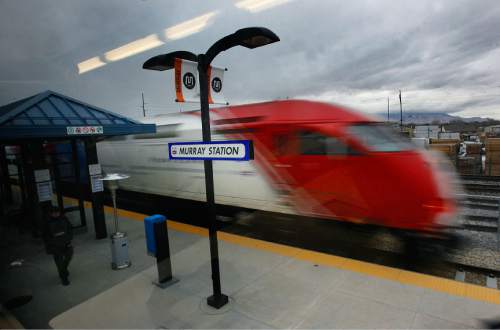This is an archived article that was published on sltrib.com in 2015, and information in the article may be outdated. It is provided only for personal research purposes and may not be reprinted.
Like most commuter railroads nationally, the Utah Transit Authority's FrontRunner may not meet a Dec. 31 deadline to fully install an automated safety system that could have prevented last month's deadly Amtrak derailment in Philadelphia.
UTA says some key components of "positive train control" (PTC) systems are now active on FrontRunner, but the agency is having trouble finding qualified people to design and install other portions required by Congress for all large railroads.
"You can imagine with all the Class 1 [large freight] railroads trying to implement PTC, the demand is high," said Dave Goeres, chief safety officer for UTA.
"There have been challenges with limited industry capacity to design and manufacture these systems, limited regulatory capacity to review and approve them, and limited qualified workers to install them on all the rail systems throughout the United States."
Attention turned to PTC — and difficulty railroads are having complying with the year-end deadline — when an Amtrak train traveling much faster than speed limits derailed and killed eight people May 12.
PTC integrates computer, satellite and radio technology to automatically slow a train that is moving too fast, avoid collisions with other trains, or stop them from entering work zones or passing switches left in the wrong position. It is active on some parts of Amtrak's Northeast Corridor, but not on the stretch where the accident occurred.
When Congress in 2008 ordered railroads to install PTC by the end of this year, it "was not a mature technology," Michael Melaniphy, president and CEO of the American Public Transportation Association, said in a written statement.
He asserts Dec. 31 "was never a realistic deadline," and commuter railroads nationally have spent $950 million trying to develop and install such systems so far — but estimates are that $3.5 billion is needed to fully implement them nationwide.
"At present, only 29 percent of commuter-rail agencies say that they can meet the deadline for PTC implementation in December," Melaniphy said.
FrontRunner is among the systems struggling to meet that deadline, Goeres said.
It has implemented some components, including speed-control elements ensuring "that trains will not travel at any speed over the safe limit along the alignment, or the trains will be shut down," he said.
That should avoid the sort of accident that happened in Philadelphia.
But UTA still is working on other elements to allow temporary speed restrictions and ensure railway-worker safety — and Goeres said the agency is in the process of making them fully operational.
"Whether they are finished by the end of the year depends on factors out of our control," Goeres said, "but we are in contact with federal officials about our PTC system."
He said those factors out of UTA's control include lack of availability of qualified people to design and install some portions and limited ability of federal officials to review and certify systems.
Some train systems have even more pessimistic outlooks.
For example, National Public Radio recently reported that the Metra commuter rail system in Chicago figures it won't be able to fully install systems there until 2019.
Melaniphy said among challenges faced by commuter-rail systems is that PTC requires more of the radio spectrum than is now available to transmit data between trains and communication towers. He said APTA has asked the Federal Communications Commission to allocate free radio spectrum for that, "yet so far, it has refused to do so."
Funding is also a problem, he said, and railroads nationally have sought to afford the required upgrades by delaying other safety-related projects, including bridge rehabilitation, and signal and track improvements. Melaniphy said Congress has allocated only $50 million to help implement PTC.
While the commuter railroad industry is "100 percent committed to developing and installing the technology," he said, implementing it nationwide "by the end of this year is not possible."
Twitter: @LeeHDavidson



